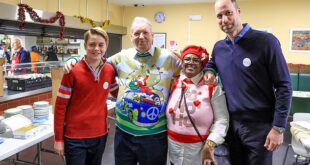GRASMERE is welcoming an intimate tribute to the work of William Heaton Cooper.
An exhibition showcasing the first 40 years of William’s life is being curated by his son Julian Cooper, Britain’s foremost living mountain painter.
The exhibition is currently open until November 28.
It will be staged at the Heaton Cooper Studio which William built and opened in 1938.
“We know that William’s work is loved and appreciated by people who love the Lake District, and especially the mountains of the Lakes,” said Julian. “But we think they will be surprised and intrigued by these earlier works.”
William Heaton Cooper was born in Coniston on October 6, 1903, the third child to a Norwegian mother Mathilde, and the landscape artist Alfred Heaton Cooper.
His early memories included playing by Mines Beck behind the house, and up on the fells above, as well as an idyllic 15 months living in Mathilde’s home village of Balestrand in Norway.
The family moved to Ambleside in 1911 and the waterfalls of Stock Beck provided adventure for William and his friends, the steep hill to the grammar school good training for following the hounds on foot, and for fell walking, and later, for rock climbing.
After leaving school at 14, William helped his father in his studio and accompanied him on painting expeditions throughout the Lake District, and sometimes by himself for a few days, ranging the fells, drawing and painting all the way, staying in farms in Wasdale, Eskdale, Dunnerdale or Buttermere.
At 19 he gained a five year scholarship to the Royal Academy Schools in London, but after winning the Creswick Prize for Landscape, which brought him £30, and he left early, deciding to survive on that and on the occasional sale of paintings at the Goupil Gallery and the Royal Academy Summer Exhibition.
He travelled to France and explored the landscape of Provence, with its brilliant light, living for a while in the caves of the Calanques.
He returned to live and paint in Sussex before moving back to London.
He painted mostly around the dockland area of the city, especially round the old port that was jammed tight with small boats. Mr Atkinson managed the Central Argentina Railway and he arranged for William to journey across Argentina to Puente del Inca, a small wooden hotel about 10,000 feet up in the Andes, and within reach of Aconcagua, the highest mountain in the Americas.
There he roamed around and made several paintings, reaching a height of 14,000 feet. “He re-joined the ship at Rosario, and had a delightful sunny journey home,” said Julian.
Back in Ambleside William began serious rock climbing, initially borrowing a rope.
“They found Gimmer Crag, making a mistaken attempt on what turned out to be a route later named Kipling Groove, not climbed until 1948,” said Julian.
“After joining the Fell & Rock Climbing Club, William climbed on all the crags with some of the leading climbers of the day, and in 1934 began to make the illustrations for the new climbing guidebooks that were being published every few years, keeping up with the new routes being done every year.”
In 1937 William had the idea of building a house and studio with a gallery in Grasmere, and
wrote a book to pay for it, ’The Hills of Lakeland’, illustrated with 52 paintings. “Frederick Warne published it in a handsome form, and it sold well from the start, with good press reviews.”
After buying a small plot of land adjoining the village green, the gallery was built and as soon as
it was finished he hung it with paintings and sold them in order to finish the whole building. It was completed in 1938.
It was here that he met the sculptor Ophelia Gordon Bell, whom he married in 1940. During the Second World War, Ophelia drove ambulances with the First Aid Nursing Yeomanry in Manchester, and William joined the Air Ministry as a camouflage officer, specialising in disguising airfields, having previously served for a short while in the local Home Guard.
The Studio at Grasmere became their home, with William’s mother Mathilde, and where their daughter Otalia was born in 1943, the first of their four children, before moving to above the valley at Winterseeds.
He died in 1995.



